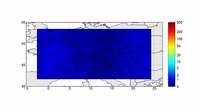Prof. Dr. László Makra, University of Szeged, Faculty of AgricultureNot a cold, but a pollen allergy
Pollen vs. health related and economic damages
Pollen vs. climate changeGlobal warming increases pollen concentrations prolongs the pollen season, and extends the habitats of allergenic taxa to the north. Hence, the number of allergic diseases increases globally; as a result, global public health risk increases [2]. Sensitization to ragweed pollen will more than double in Europe, from 33 million people (1986-2005) to 77 million by 2041-2060 [3].
A 2D animation based on a Europe-wide station database illustrates the daily change in ragweed pollen concentration from the beginning to the end of the pollen season, showing well the areas in Europe where those sensitive to ragweed pollen are at increased health risk. [6]
A 3D animation based on a Europe-wide station database illustrates the daily change in ragweed pollen concentration from the beginning to the end of the pollen season, showing well the areas in Europe where those sensitive to ragweed pollen are at increased health risk. [6]
In addition to aerosols of local origin, aerosols that travel thousands of kilometres from their place of origin with air currents increase the biological activity of pollen grains, and thus the health risk of those who are sensitive to them. [7]
Pollen vs. atmospheric CO2 level Due to the increase in atmospheric CO2 level, pollen production and, as a result, the number of allergic diseases also increase [4].
Pollen vs. COVID interactions
Pollen is a major concern for many respiratory and non-respiratory diseases (conjunctivitis, rhinitis, asthma, etc.). Even if you are healthy, coexposure of air pollution and airborne pollen enhances susceptibility to respiratory viral infections. In addition, the ever-increasing environmental stress (chemicals, plastics and other artificial materials in everyday life), as well as global warming induced increasing pollen concentrations involve a great threat and at the same time a great challenge for humanity, to which we must prepare and respond appropriately.
Keywords: pollen, allergy, climate change, social and economic damages, pollen vs. COVID interactionsReferences
[2] Ziska, L.H., Makra, L., Harry, S.K., Bruffaerts, N., Hendrickx, M., Coates, F., Saarto, A., Thibaudon, M., Oliver, G., Damialis, A., Charalampopoulos, A., Vokou, D., Heiđmarsson, S., Guđjohnsen, E., Bonini, M., Oh, J-W., Sullivan, K., Ford, L., Brooks, G.D., Myszkowska, D., Severova, E., Gehrig, R., Ramón, G.D., Beggs, P.J., Knowlton, K., Crimmins, A.R., 2019: Temperature-related changes in airborne allergenic pollen abundance and seasonality across the northern hemisphere: a retrospective data analysis. The Lancet Planetary Health, 3(3):e124–e131. doi: 10.1016/S2542-5196(19)30015-4
[3] Lake, I., Colon, F., Jones, N., 2018: Quantifying the health effects of climate change upon pollen allergy: a combined cohort and modelling study. The Lancet Planetary Health, 2, S16.
[4] Ziska, L.H., 2003: Evaluation of the growth response of six invasive species to past, present and future atmospheric carbon dioxide. Journal of Experimental Botany 54 (381), 395-404.
[5] Damialis, A., Gilles, S., Sofiev, M., Sofieva, V., Kolek, F., Bayr, D., Plaza, M.P., Leier-Wirtz, V., Kaschuba, S., Ziska, L.H., Bielory, L., Makra, L., del Mar Trigo, M., COVID-19/POLLEN study group, Traidl-Hoffmann, C., 2021: Higher airborne pollen concentrations correlated with increased SARS-CoV-2 infection rates, as evidenced from 31 countries across the globe. PNAS, 118(12), e2019034118, pp. 1-10. doi: 10.1073/pnas.2019034118;
[6] Makra, L., †Matyasovszky, I., Tusnády, G., Ziska, L.H., Hess, J.J., Nyúl, L.G., Chapman, D.S., Coviello, L., Gobbi, A., Jurman, G., Damialis, A., Reiczigel, J., Schneider, N., Szabó, B., Csépe, Z., Sümeghy, Z., Páldy, A., Magyar, D., Mányoki, G., Erostyák, J., Bergmann, K.C., Deák, Á.J., Thibaudon, M., Albertini, R., Bonini, M., Šikoparija, B., Radišić, P., Mitrović Josipović, M., Gehrig, R., Severova, E., Rodinkova, V., Stjepanović, B., Ianovici, N., Berger, U., Kofol Seliger, A., Rybníček, O., Myszkowska, D., Dąbrowska-Zapart, K., Majkowska-Wojciechowska, B., Weryszko-Chmielewska, E., Grewling, Ł., Rapiejko, P., Malkiewicz, M., Šaulienė, I., Shalaboda, V., Prikhodko, A., Maleeva, A., Yankova, R., Peternel, R., Ščevková, J., Bullock, J.M., 2021: New maps of airborne ragweed pollen concentrations, ragweed phenology and frost related characteristics for Europe Application of the Gaussian method and the use of deep learning to reconstruct missing daily pollen concentrations: the first recovered station databases. Global Change Biology (before submission)
[7] Bartra, J., Mullol, J., del Cuvillo, A., Davila, I., Ferrer, M., Jauregui, I., Montoro, J., Sastre, J., Valero, A., 2007: Air pollution and allergens. J Investigational Allergy and Clinical Immunology, 17, Suppl. 2, 3-8.
[8] Ziska, L.H., Makra, L., Harry, S.K., Bruffaerts, N., Hendrickx, M., Coates, F., Saarto, A., Thibaudon, M., Oliver, G., Damialis, A., Charalampopoulos, A., Vokou, D., Heiđmarsson, S., Guđjohnsen, E., Bonini, M., Oh, J-W., Sullivan, K., Ford, L., Brooks, G.D., Myszkowska, D., Severova, E., Gehrig, R., Ramón, G.D., Beggs, P.J., Knowlton, K., Crimmins, A.R., 2019: Temperature-related changes in airborne allergenic pollen abundance and seasonality across the northern hemisphere: a retrospective data analysis. The Lancet Planetary Health, 3(3):e124–e131. doi: 10.1016/S2542-5196(19)30015-4
Damialis, A., Gilles, S., Sofiev, M., Sofieva, V., Kolek, F., Bayr, D., Plaza, M.P., Leier-Wirtz, V., Kaschuba, S., Ziska, L.H., Bielory, L., Makra, L., del Mar Trigo, M., COVID-19/POLLEN study group, Traidl-Hoffmann, C., 2021: Higher airborne pollen concentrations correlated with increased SARS-CoV-2 infection rates, as evidenced from 31 countries across the globe. PNAS, 118(12), e2019034118, pp. 1-10. doi: 10.1073/pnas.2019034118





















 Not a cold, but a pollen allergy
Not a cold, but a pollen allergy
 Pollen vs. health related and economic damages
Pollen vs. health related and economic damages
 Pollen vs. climate change
Pollen vs. climate change



 Pollen vs. atmospheric CO2 level
Pollen vs. atmospheric CO2 level
 Pollen vs. COVID interactions
Pollen vs. COVID interactions

